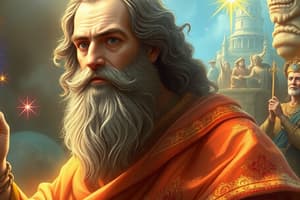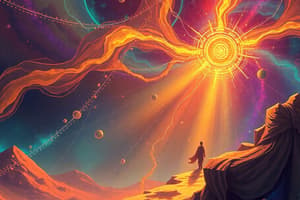Podcast
Questions and Answers
Which of the following best describes the central argument presented by John Lennox in his debates with Richard Dawkins?
Which of the following best describes the central argument presented by John Lennox in his debates with Richard Dawkins?
- The perceived conflict between science and religion is actually a conflict between naturalism and theism. (correct)
- Christianity historically hindered scientific advancement, but modern interpretations allow for coexistence.
- Scientific progress disproves the existence of God.
- Science and Christianity are fundamentally incompatible due to their reliance on different methodologies.
Francis Bacon is credited with formalizing which of the following methodologies essential to scientific inquiry?
Francis Bacon is credited with formalizing which of the following methodologies essential to scientific inquiry?
- Reliance on ancient texts for scientific truths.
- Mathematical modeling of natural phenomena.
- Empirical observation and inductive reasoning. (correct)
- Deductive reasoning from established principles.
Karl Popper's concept of falsifiability posits that a scientific theory is only valid if it:
Karl Popper's concept of falsifiability posits that a scientific theory is only valid if it:
- Is supported by a large body of evidence.
- Is testable and potentially disprovable through experimentation. (correct)
- Has practical applications and benefits to society.
- Can be proven true through repeated experimentation.
Thomas Kuhn's model of scientific progress is best described by which statement?
Thomas Kuhn's model of scientific progress is best described by which statement?
Which of the following best characterizes Aristotle's concept of teleology in the context of his scientific views?
Which of the following best characterizes Aristotle's concept of teleology in the context of his scientific views?
Ptolemy's geocentric model of the universe, which persisted for over a thousand years, posited that:
Ptolemy's geocentric model of the universe, which persisted for over a thousand years, posited that:
Democritus's atomic theory, though lacking experimental verification, was significant because it proposed that:
Democritus's atomic theory, though lacking experimental verification, was significant because it proposed that:
Copernicus challenged the prevailing astronomical model by proposing the heliocentric model, which stated that:
Copernicus challenged the prevailing astronomical model by proposing the heliocentric model, which stated that:
Tycho Brahe's model of the solar system can best be described as:
Tycho Brahe's model of the solar system can best be described as:
Galileo Galilei provided observational evidence supporting heliocentrism through his telescope discoveries. Which of the following is NOT one of his key observations?
Galileo Galilei provided observational evidence supporting heliocentrism through his telescope discoveries. Which of the following is NOT one of his key observations?
Johannes Kepler refined the heliocentric model by demonstrating through his three laws of planetary motion that:
Johannes Kepler refined the heliocentric model by demonstrating through his three laws of planetary motion that:
Isaac Newton's laws of motion include which of the following principles?
Isaac Newton's laws of motion include which of the following principles?
John Dalton's atomic theory posited that:
John Dalton's atomic theory posited that:
Dmitri Mendeleev organized the elements in the periodic table based on their atomic mass and observed periodic properties. What was a significant outcome of this arrangement?
Dmitri Mendeleev organized the elements in the periodic table based on their atomic mass and observed periodic properties. What was a significant outcome of this arrangement?
J.J. Thomson's cathode ray tube experiment led to the discovery of:
J.J. Thomson's cathode ray tube experiment led to the discovery of:
Ernest Rutherford's gold foil experiment demonstrated that:
Ernest Rutherford's gold foil experiment demonstrated that:
Niels Bohr modified Rutherford's model of the atom by proposing that:
Niels Bohr modified Rutherford's model of the atom by proposing that:
Albert Einstein's theory of relativity, particularly the equation $E=mc^2$, demonstrates:
Albert Einstein's theory of relativity, particularly the equation $E=mc^2$, demonstrates:
Lise Meitner's key contribution to physics was the:
Lise Meitner's key contribution to physics was the:
Gerhard Domagk's discovery of Prontosil was significant because it:
Gerhard Domagk's discovery of Prontosil was significant because it:
Fritz Haber is best known for:
Fritz Haber is best known for:
In scientific notation, which of the following represents the number 5,280,000?
In scientific notation, which of the following represents the number 5,280,000?
The 'God of the gaps' argument is often criticized because it:
The 'God of the gaps' argument is often criticized because it:
The 'Two Books of Revelation' concept suggests that truth is revealed through:
The 'Two Books of Revelation' concept suggests that truth is revealed through:
Which of the following is NOT considered a key characteristic of scientific inquiry?
Which of the following is NOT considered a key characteristic of scientific inquiry?
According to the traditional conception of science, what is the ultimate goal of scientific inquiry?
According to the traditional conception of science, what is the ultimate goal of scientific inquiry?
The principles of empirical evidence, objectivity, and rationality are crucial to science because they:
The principles of empirical evidence, objectivity, and rationality are crucial to science because they:
Reductionism, as a scientific approach, suggests that:
Reductionism, as a scientific approach, suggests that:
What is the primary distinction between methodological naturalism and philosophical naturalism?
What is the primary distinction between methodological naturalism and philosophical naturalism?
Retrograde motion, the apparent backward movement of planets as viewed from Earth, is primarily due to:
Retrograde motion, the apparent backward movement of planets as viewed from Earth, is primarily due to:
Flashcards
Richard Dawkins
Richard Dawkins
Argues faith is for the blind, science is evidence-based, and religion hinders scientific progress.
John Lennox
John Lennox
Argues Christianity propelled scientific advancement and the real battle is between naturalism and theism.
Francis Bacon
Francis Bacon
Developed the scientific method, emphasizing empirical observation and inductive reasoning.
Karl Popper
Karl Popper
Signup and view all the flashcards
Thomas Kuhn
Thomas Kuhn
Signup and view all the flashcards
Aristotle
Aristotle
Signup and view all the flashcards
Ptolemy
Ptolemy
Signup and view all the flashcards
Nicolaus Copernicus
Nicolaus Copernicus
Signup and view all the flashcards
Tycho Brahe
Tycho Brahe
Signup and view all the flashcards
Galileo Galilei
Galileo Galilei
Signup and view all the flashcards
Johannes Kepler
Johannes Kepler
Signup and view all the flashcards
Isaac Newton
Isaac Newton
Signup and view all the flashcards
John Dalton
John Dalton
Signup and view all the flashcards
Dmitri Mendeleev
Dmitri Mendeleev
Signup and view all the flashcards
J.J. Thompson
J.J. Thompson
Signup and view all the flashcards
Ernest Rutherford
Ernest Rutherford
Signup and view all the flashcards
Niels Bohr
Niels Bohr
Signup and view all the flashcards
Albert Einstein
Albert Einstein
Signup and view all the flashcards
Lise Meitner
Lise Meitner
Signup and view all the flashcards
Gerhard Domagk
Gerhard Domagk
Signup and view all the flashcards
Fritz Haber
Fritz Haber
Signup and view all the flashcards
Powers of 10
Powers of 10
Signup and view all the flashcards
Antibiotics
Antibiotics
Signup and view all the flashcards
God of the Gaps
God of the Gaps
Signup and view all the flashcards
Two Books of Revelation
Two Books of Revelation
Signup and view all the flashcards
Characteristics of Science
Characteristics of Science
Signup and view all the flashcards
Steps in the Scientific Method
Steps in the Scientific Method
Signup and view all the flashcards
Limits of Science
Limits of Science
Signup and view all the flashcards
Traditional Conception of Science
Traditional Conception of Science
Signup and view all the flashcards
Popper’s Falsification
Popper’s Falsification
Signup and view all the flashcards
Study Notes
- Faith is believed to be for the blind, science relies on evidence.
- Religion, according to Richard Dawkins, obstructs scientific advancement, hindering coexistence.
- John Lennox contends that Christianity propelled scientific advancement, the core conflict lies between naturalism and theism.
- Francis Bacon developed the Scientific Method, which uses empirical observation and inductive reasoning for knowledge through experiments.
- Karl Popper's falsifiability theory suggests scientific knowledge advances by testing and rejecting hypotheses.
- Thomas Kuhn posited that science progresses through revolutions where dominant theories replace previous ones.
- Aristotle introduced deductive reasoning, where conclusions logically follow general principles.
- Aristotle's teleology suggests everything in nature has a purpose.
- Aristotle thought that all matter consists of earth, water, air, fire, and aether.
- Ptolemy’s geocentric model, which places Earth at the center of the universe, was accepted for 1000 years.
- Democritus proposed the atomic theory that the world consists of atoms, though he didn't prove it with experiments.
- Copernicus proposed the heliocentric model, positioning the sun at the center of the universe.
- Tycho Brahe created a hybrid model, with Earth stationary and the sun orbiting Earth.
- Galileo Galilei discovered the telescope and was arrested for supporting heliocentrism.
- Johannes Kepler found that planets orbit the sun in ellipses.
- Kepler's work supported the heliocentric model of the solar system.
- Isaac Newton supported the three laws of motion and universal gravitation.
- Newton's first law is the Law of Inertia.
- Newton's second law is the Law of Acceleration.
- Newton's third law is the Action-Reaction Law.
- John Dalton proposed that all matter consists of indivisible atoms.
- Dmitri Mendeleev created the periodic table, organizing elements by atomic mass.
- J.J. Thompson discovered the electron in 1897 through his cathode ray tube experiment.
- Thompson's discovery led to the plum pudding model of the atom.
- Ernest Rutherford's gold foil experiment led to the discovery of the nucleus.
- Niels Bohr proposed that electrons orbit the nucleus in fixed energy levels.
- Albert Einstein proposed the Theory of Relativity, with E=mc², describing the relationship between energy and mass.
- Lise Meitner discovered nuclear fission, explaining how splitting atomic nuclei releases vast energy.
- Gerhard Domagk discovered Prontosil, the first commercially available antibiotic, leading to sulfa drugs.
- Fritz Haber proposed the Haber-Bosch process, enabling large-scale ammonia production for synthetic fertilizers.
Key Terms and Concepts
- Powers of 10 express large or small numbers in scientific notation.
- Antibiotics kill or inhibit bacterial growth by targeting bacterial structures/functions.
- God of the Gaps attributes unknown phenomena to divine intervention.
- Two Books of Revelation suggests God reveals truth through nature and scripture.
- Science is empirical, objective, and rational, relying on observation, experimentation, and logical reasoning.
- The Scientific Method includes observation, hypothesis, experimentation, and conclusion.
- Science cannot address moral, aesthetic, or supernatural questions.
- Science seeks universal truths through systematic observation and experimentation.
- Empirical means that science relies on evidence
- Objectivity means that science relies on unbiased observation
- Rationality means that science relies on logical reasoning.
- Popper’s Falsification states that a scientific theory must be testable and falsifiable.
- Kuhn’s Paradigms and Scientific Revolutions say science progresses through shifts in dominant theories (paradigms).
- Scientific theories are shaped by fundamental principles and empirical data.
- Reductionism suggests a complex system can be understood by studying its simpler parts.
- Determinism says all events follow causal laws.
- Materialism states everything is physical.
- Scientism claims science is the only path to knowledge.
- Christian theism believes in a divine creator.
- Naturalism rejects the supernatural.
- Postmodernism questions absolute truth. Methodological Naturalism
- Assumes natural causes for phenomena and does not consider supernatural explanations. Retrograde Motion
- Is the apparent backward motion of planets due to Earth's movement. Epicycle
- A small circular orbit within a planet’s main orbit, used in the geocentric model. Heliocentric, Geocentric
- Heliocentric places the Sun at the center, and the geocentric places Earth at the center of the universe. Aristotle’s Science
- Consists of earth, water, air, fire, and aether, focusing on purpose (teleology) and logical deduction. Newton’s Laws of Motion
- Objects remain in motion unless acted on, force equals mass times acceleration, and every action has an equal and opposite reaction. Newton’s Law of Universal Gravity
- Every mass attracts every other mass, force relies on mass and distance. Deism, Clockwork Universe
- Deism believes in a non-intervening creator, and the universe operates like a predictable machine. Average Speed, Instantaneous Speed
- Average speed is total distance divided by time, and instantaneous speed is speed at a specific moment. Derivative, Power Rule for Derivatives
- A derivative measures how a function changes, and the power rule states d/dx [xⁿ] = n*xⁿ⁻¹. Number Systems
- Ancient civilizations developed unique numerical notations, and Indian numerals evolved into the modern decimal system. Algebra, Imaginary Number (i)
- Algebra solves equations using symbols, and the imaginary unit (i) represents the square root of -1. Proton, Neutron, Electron
- Protons and neutrons are in the nucleus, while electrons orbit.
- Protons are positive, neutrons are neutral, and electrons are negative. Gold Foil Experiment
- Showed atoms have a dense nucleus, and most of an atom is empty space. Nucleus, Isotope, Ion, Notation
- ²³Na⁺ represents what protons and neutrons are in the nucleus.
- Isotopes have different neutron counts, and ions are charged atoms. Elements, Periodic Table
- Elements are pure substances, and the periodic table organizes them by atomic number and properties. Nuclear Fission
- The splitting of atomic nuclei releases energy and also powers nuclear reactors and bombs. Manhattan Project
- A secret WWII project that developed nuclear weapons and bombings of Hiroshima and Nagasaki. Ionic Bonding, Non-Polar and Polar Covalent Bonding
- Ionic bonding transfers electrons, while covalent bonding shares them.
- Polar bonds have unequal sharing, while non-polar bonds share equally. Intermolecular and Intramolecular Forces
- Intermolecular forces act between molecules, Intramolecular forces hold atoms together within molecules. Essential Molecules
- These molecules are crucial for life, they include water (H₂O), oxygen (O₂), and carbon dioxide (CO₂). Haber-Bosch Process
- An industrial method for synthesizing ammonia, and also supports large-scale agriculture through fertilizer production. Nitrogen Fixation
- The process of converting atmospheric nitrogen into usable forms. Nitrogen Cycle
- The movement of nitrogen through ecosystems, fixation, assimilation, nitrification, and denitrification. Eutrophication, Algae Blooms, Dead Zones
- Excess nutrients cause algal overgrowth, this depletes oxygen and kills aquatic life.
Studying That Suits You
Use AI to generate personalized quizzes and flashcards to suit your learning preferences.





